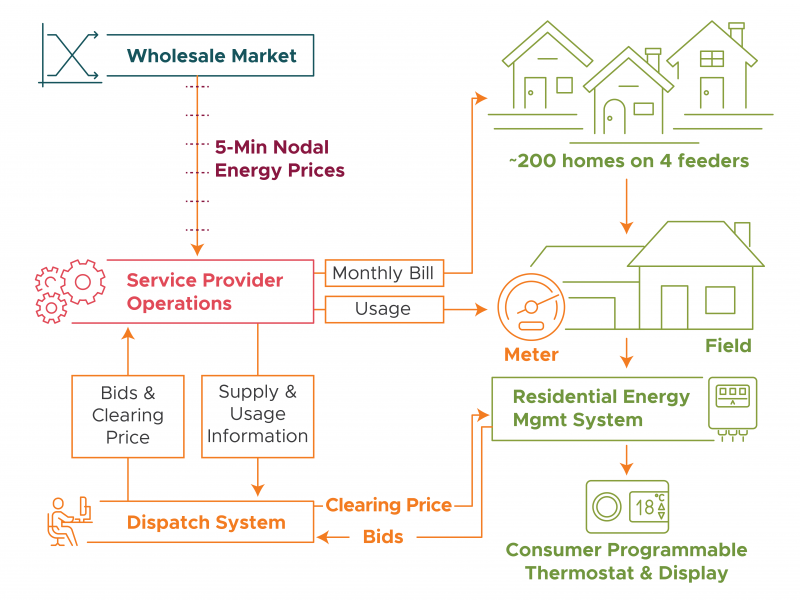AEP gridSMART Demonstration Project
The American Electric Power’s gridSMART™ Project featured a consumer-oriented Real-Time Pricing–Double Auction (RTPda) demonstration. The project engaged residential households to adapt electricity use in response to a fluctuating five-minute price signal. In-home intelligent software interacts in real-time with locational price signals derived from the PJM regional transmission organization’s wholesale market in real-time, obtained a cleared energy price and managed heating, ventilation, and air conditioning (HVAC) systems. The real-time tariff approved by the Public Utility Commission of Ohio (Schedule RS-RTP, 2012) describes the wholesale market price.
The retail energy market helped determine which space conditioning systems would run in the five-minute operating intervals as a function of the cleared price. The design combined:
- a retail price that reflected the nodal PJM wholesale locational marginal price and capacity values;
- a retail tariff designed to provide a significant savings opportunity while being revenue neutral for the average consumer in the absence of any load shifting. A monthly wholesale-price adjustment factor was applied to robustly protect the consumer and the utility from unusual excursions in wholesale market prices;
- a retail double-auction market design that directly managed capacity constraints at the distribution feeder level and simultaneously managed each feeder’s share of American Electric Power’s peak demand costs;
- an economically rational heating/cooling thermostat design that balances a consumer’s desire to save on their electric bill in exchange for their willingness to be flexible, and that bids the price at which the load it controls will operate (or not), plus the quantity of that load; and
- a price-normalization scheme that eliminates the need for consumers to specify absolute price levels and that adapts to both short-term (days) and long-term (years) changes in average prices.

A simplified diagram of the project is shown above. Within the home an electronic program-controlled thermostat (ePCT) communicates with an HVAC unit and a home energy manager (HEM). The HEM hosts a software agent that monitors the market price of electricity and converts the residents’ desired temperature set point, the current deviation from that set point, and their preference setting for relative comfort and savings into an amount they are willing to bid for the next five minutes of electricity.
Researchers analyzed the behavior of the nearly 200 participating households from June 1 to September 30, 2013. From a system impact point of view, the results showed that with a 35 percent penetration of RTPda households, a load reduction of about 5 percent could be obtained for a 3.5-hour system peak event.
Household surveys reflected satisfaction with the program. Only 4 percent of the consumers overrode their thermostat settings at some point during the two-hour congestion events, and 10 percent during the four-hour events. This response reduction indicates a modest degree of “customer fatigue” that is inherent in all price-responsive demand programs during summer peak pricing events.